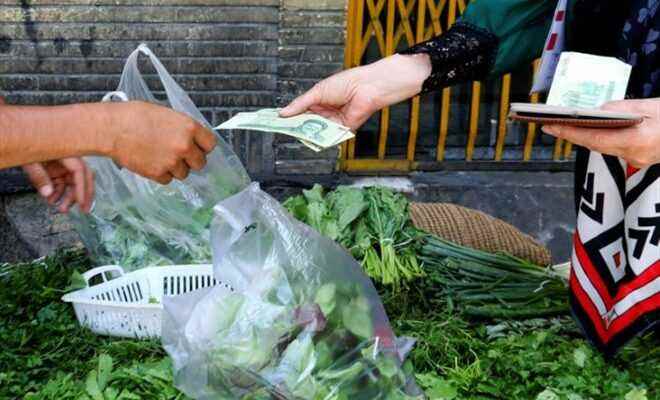A butcher prepares a meat order in his shop on June 15, 2022 in Tehran, Iran (AFP/ATTA KENARE)
In his butcher’s shop in the popular district of Molavi in Tehran, Ali dexterously cuts up the carcass of a sheep in front of a dozen customers whose only subject of conversation is galloping inflation.
Salt and pepper hair, he looks gray when he talks about the dizzying rise in prices which is reducing his clientele.
“What can I tell you? My sales have dropped by almost half. I’m a butcher and there are weeks when I don’t eat meat. The prices keep going up,” he told AFP. AFP
On the sidewalk, Ali hands Asghar, a 63-year-old retired civil servant, a bag containing pieces of meat for him and his wife.
“We used to buy a lot more but that’s over. Everyone is cutting back, we’re all under pressure,” he says.
According to figures circulating in the media, the prices of red meat have increased by 50%, those of chicken and milk have doubled, while cooking oil has quadrupled.

The Tajrish market in Tehran on June 15, 2022 in Iran (AFP/ATTA KENARE)
Iranians, who appreciate good cuisine where meat goes well with rice, spices and other flavors, now fall back on bread, chicken, even if the price of poultry and eggs has doubled mid-May with the end of subsidies.
The bread that escaped this inflation became the most popular food. Its price is stable after the government’s commitment that the price increase will not affect this commodity as well as fuel and medicines.
– Bread demand on the rise –
At his traditional bakery in southern Tehran, Mojtaba, 29, says his sales have increased since President Raisi, who came to power in August, made the promise.

A baker prepares bread on June 15, 2022 in Tehran, Iran (AFP/ATTA KENARE)
“We are cooking extra quantities because people are resorting to bread, because they cannot buy rice, cooking oil, pasta. Some people now eat almost exclusively bread,” he explains. kneading the dough for a new batch in his oven dug into the ground.
“The queues at the bakeries have gotten longer,” said Shadi, a housewife who wears a black chador, bitterly.
Iran is facing a severe economic crisis due in large part to sanctions imposed by former US President Donald Trump upon his unilateral withdrawal from the Iran nuclear deal in 2018.
The crisis has led to a depreciation of the currency, with inflation exceeding 40% per year since 2018, according to experts.
The rial bottomed out this week after the IAEA passed a resolution against Iran, dimming prospects for a deal and lifting of sanctions. Sunday, it took 337,000 rials for one dollar, 25% more than at the end of March and ten times more than in 2017.
For the economic analyst Saïd Laylaz, “over the past four years the country has been confronted with the most severe inflation since the Second World War”.

A table shows exchange rates between different currencies on June 15, 2022 in Tehran, Iran (AFP/ATTA KENARE)
It accelerated after the announcement in mid-May by President Ibrahim Raisi of a change in the subsidy system, resulting in a surge in the prices of basic products such as flour, meat, eggs and cooking oil. .
Hundreds of Iranians have protested in several cities in recent weeks. These protest movements have been added to others that have been going on for months in various sectors to obtain better wages and an increase in the level of retirement pensions.
– Ministerial resignation –
On Tuesday, Labor Minister Hojatollah Abdolmaléki resigned, citing his desire to see “improvement in the services provided to the population”, according to government spokesman Ali Bahadori-Jahromi.

A customer buys vegetables at a market in Tehran on June 15, 2022 in Iran (AFP/ATTA KENARE)
But for the reformist newspaper Etemad, his resignation follows the “scathing criticism he received from pensioners”.
For Mr. Laylaz, two reasons explain the rise in prices: the “sharp increase in inflationary tendencies in the world” with the conflict in Ukraine, and “the beginning of the enormous economic reforms (…) in Iran which will inevitably lead to inflation additional”.
For this expert, former economic adviser to several Iranian presidents, many are exasperated by the removal of the subsidized exchange rate, in place since 2018, which allowed the import, at a favorable rate, of basic products such as wheat, cooking oil and medical equipment.
But for Mr. Laylaz this suppression of the exchange rate was inevitable, especially since the talks with the major powers on nuclear power have not yet resulted in an agreement lifting the sanctions.
“If Iran had wanted to keep the preferential rate like in previous years, we would have needed $22 billion this year,” he said.
© 2022 AFP
Did you like this article ? Share it with your friends with the buttons below.




